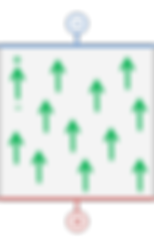
The Piezoelectric Effect
The piezo effect was discovered in the year 1880 by the brothers Jacques and Pierre Curie.
During experiments with Tourmaline crystals they found that electrical charges appeared on the surface when the crystal was mechanically deformed. The quantity of the electrical charge was exactly proportional to the load applied.
When a piezoelectric material is mechanically deformed the electric charges contained within the elementary cells get displaced and form an electrical field over the entire body. The so produced charge can be collected on the respective surfaces of the piezoelectric body. This is called the direct piezo effect.
The piezo effect is also invertible. If we apply a voltage across the same surfaces, the piezoelectric body will deform itself in a similar way. This phenomenon is called the inverse (or converse) piezo effect.
We retain:
-
Piezoelectric materials are extremely sensitive to mechanical deformation.
-
The relation between charge output and input force is strictly linear (the amount of charge follows exactly the force).
-
The charge is produced due to the deformation of the piezo however this deformation is extremely small.
-
Most of the piezo materials are quite rigid, in many cases comparable to a material like aluminum. In engineering terms: A common value for the Youngs modulus is in the order of 70 GPa.
Elementary Charge
In order to really understand the mechanism in a piezoelectric material, we have to dig down deep into the matter.
So let's go back to the atoms again. The electrical charge carried by one electron is called elementary charge. The elementary charge is a fundamental physical constant.
The elementary charge is normally denoted as "e" for the charge of the proton and "– e" for the electron. By convention, the electrons have a negative (minus) charge, and the protons have a positive (plus) charge.
The magnitude of the elementary charge is e = 1.6 · 10⁻¹⁹ (Coulomb)
(From this perspective a pC is not so small as it equals to 6.25 millions of electrons.)
Electric Dipole Moment
An electric dipole moment p is characterized by the spatial separation of electric charges. It is the measure of the separation between a positive charge +q and its negative counterpart –q.
If a molecule shows regions with electrical charges of different signs, and the centers of gravity of the negative charges (electrons) and the positive charges (protons) are not coincident, then this molecule has an electric dipole moment p.
The electric charge –q at a distance d from a same but positive charge +q represent an electric dipole p
p = q · d
p and d are vectors
(That's why they are written in bold)
d is pointing from the negative to the positive charge.

A very well known electric dipole is the water molecule.
As the sole electron of the hydrogen is attracted by the electron vacancy of the oxygen atom the negative charge of the hydrogen is partially displaced towards the oxygen. This means that the hydrogen gets a positive partial charge while the oxygen on the other hand gets a negative partial charge.
(the partial charges are shown with δ+ and δ-)

Hydrogen
Oxygen
Piezoelectricity on Molecular Level
The piezo electric effect occurs on certain crystals or crystalline materials when they are deformed mechanically whereby internal electric charges get displaced and form electric dipole moments.
The two basic conditions for a material to be piezoelectric are that the material must have a crystalline structure with polar axes but without a symmetry center.
Here we see a well known crystal, table salt (Na Cl).
The structure of such crystals is built up by ions which in fact have different polarities, they stick together due to their mutual electrostatic attraction.
So why is table salt not piezoelectric?
This is because the structure is completely symmetric and any electric dipole moment is canceled out by the neighbouring pair of ions. The deformation of the crystal lattice with a symmetry center does not alter the center of gravity of the electrical charges. Hence it will not be piezoelectric.

Chloride ion Cl⁻
Sodium ion Na⁺
Sodium Chloride ionic crystal lattice
Typically, such a structure is described by a crystal lattice defined by a set of nodes, an elementary pattern. Only if a crystal lattice does not have a symmetry center, the centers of gravity of the charges are displaced by the deformation and a so-called polarization occurs. The positive and negative elements are dislocated in a way that electric dipole moments are generated. Each building element of a piezoelectric crystal has an asymmetry which forms an electric dipole moment.
In the unstressed state all remaining charges will cancel out and there is no resulting net charge to observe.
Piezo Crystals
If we talk about crystals in this context we normally mean a single crystal. I.e. a body made from only one continuous crystal.
Probably the most famous piezoelectric crystal is the quartz. Quartz can be found in the nature but for technical applications it is normally man-made.

Natural quartz
The chemical formula of quartz is Si O2 i.e. two oxygen atoms per one silicon atom. However the oxygen atoms will try to form a tetrahedron around each silicon atom meaning four oxygens per silicon.
In a quartz crystal we will find such Si O4 tetrahedrons but they all share the oxygens with the adjacent tetrahedrons in a way that the overall count is two oxygens for one silicon.
In an Si-O bond the negative electrons get drawn more to the oxygen (such a bond is called polar, and oxygen is said to have a higher electronegativity than silicon), so the oxygen is more negatively and the silicon more positively charged.

Oxygen O
Silicon Si
Silicon - oxygen tetrahedron
(the size of the atoms is not to scale)
When we compare with the simple salt crystal above, the quartz is built up with much more complexity. The picture on the right shows the basic building block of quartz. It consists of 3 Si-O tetrahedrons. The Si atoms in the centers are located on the surfaces of a regular triangular prism. An identical prism on the right is "empty" and acts as a placeholder.
The three Si-O tetrahedrons are rotated by 120° and shifted in the vertical axis. Each one is linked to the next through one of the oxygen atoms and together they form a spiral structure.

Basic building block of quartz
By stacking up such basic units we get a whole string of tetrahedrons and the spiral staircase character can be seen quite a bit better.
The spiral is built along the z-axis of the crystal. The rotation sense of the spiral can be either to the right or to the left. We are talking then about a right-handed or left-handed quartz.

Spiral arrangement of a (right-handed) quartz
When we add some more of the basic triangular prisms and look from the bottom, i.e. in the z-axis of the crystal, it will look like shown on the right.
We now can see very clearly the hexagonal shape which appears also in the macroscopic shape of the crystal. We also can see that the "empty space" is now filled out and that all the oxygens inside the crystal have found a silicon atom with whom they can share an electron.
The oxygens at the surface of the crystal will normally bind a hydrogen.

View in direction of the z-axis. The hexagonal caracter in this direction is clearly visible.
When such a tetrahedron element is deformed mechanically the center of gravity of the negative charges of the oxygens will be dislocated with respect to the positive charges of the silicon and due to the asymmetric arrangement the net electric dipole moment p will appear. In the illustration the respective charges are shown in blue (-) and red (+).
( Hover with the mouse pointer over the picture to apply a vertical load.) The deformation is of course highly exaggerated to show the effect.


Change of the net electric dipole moment by mechanical deformation
This picture shows a simplified model of a quartz structure, with all Si O4 units being oriented the same way. Every dot repesents a tetrahedron which are arranged in hexagons. In reality, as we have seen, the situation is far more complex. Although the real orientation of the tetrahedrons is somewhat different all of them will be affected with their central Si atom pushed downwards when a vertical load is applied. All Si O4 units are polarized in the same way.
With the load applied we can see that all the little dipoles of one plane are in series with the dipoles of the other planes. The negative charge at the top is always canceled out by the positive charge of the dipole of the next layer which means that the resulting net charges only appear at the top and bottom surface of the body.


Simplified model of a quarz structure showing the charge distribution. Blue (-) red (+).
Note that the pink colour is due to blue and red overlapping
This suggests that the charge we measure across the surfaces of a quartz plate is independent of the thickness of the plate.
However if we look at the residual voltage we can deduct, in view of all the internal elements in series, that the voltage will increase with the thickness of the plate.
If I stimulated your appetite to discover more on Quartz.....

I can warmly recommend
"The Quartz Page"
a highly intersting and comprehensive Webpage by A.C. Akhavan from whom I learned quite a lot
Piezoelectric Ceramics
Another group of piezoelectric materials are the piezo ceramics. While single crystals may be found in the nature or may be man-made all the piezo ceramics are man-made.
One of the world’s most widely used piezoelectric ceramic material is lead zirconate titanate or PZT.
PZT is a mix of lead zirconate and lead titanate and form so-called perovskite crystals.
The base unit of such perovskite crystals is a cube built with divalent lead (Pb) ions in the corners and oxygen ions in the center of each face. Inside this structure we find a small, tetravalent metal ion, titanium or zirconium.
For this crystal structure two phases exist over the temperature range. Above a certain temperature, called Curie-temperature, the perovskite crystal exhibits a simple cubic symmetry. It is completely symmetric with no dipole moment.

Pb ²⁺
Ti ⁴⁺ or Zr ⁴⁺
O ²⁻
Above the Curie point:
Cubic lattice. Symmetric arrangement of positive and negative charges. No dipole moment
Below the Curie-temperature however, the crystal cube is stretched a bit in one direction and the tetravalent Ti or Zr ion is squeezed out of the center forming a tetragonal symmetry and thereby a dipole moment. This happens by itself and is called spontaneous polarization.
As we can see from the cubic arrangement there are six possible directions to form a dipole moment.


Below the Curie point:
Tetragonal (orthorhombic) lattice. Position of central positive metal ion is shifted up, creating an electric dipole moment p with the oxygen ions.
Poling of Piezo Ceramic
In contrast to a single crystal a ceramic is conglomerate of crystallites which stick together due to a process called sintering. Adjoining dipoles align themselves. Groups of dipoles with parallel orientation are called Weiss domains.
The alignment provides a net dipole moment to the domain, and thus a net polarization of this domain.
The direction of polarization in the different domains is completely random so the ceramic element has no overall polarization. However the domains in a ceramic element may be aligned.
By heating it close to the Curie temperature and exposing it to a strong electric field the polarization of the domains can be aligned and “freeze up” when the electric field is removed.
Through this polarizing treatment called poling the domains expand with the electric field and the element lengthens somewhat in the direction of the field.

Random orientation of different Weiss domains

Polarization in a strong DC electric field
Durin cooling, even with the electric field removed, most of the dipoles are locked into a configuration of near alignment. However, the alignment of the dipole moments will not be perfectly straight because each domain has distinctly allowed directions. The element now has a permanent or remnant polarization and is piezoelectric.

Remnant polarization after removal of the electric field
We can now understand that heating of a piezo element above the Curie temperature will destroy the alignment of the polarization and thereby the integral piezo effect of the element.


